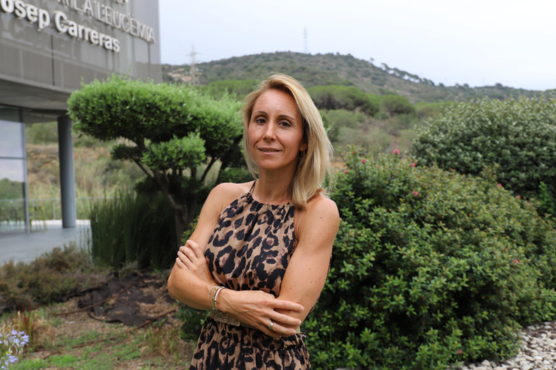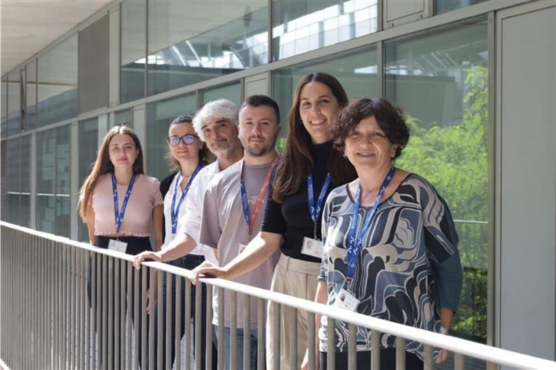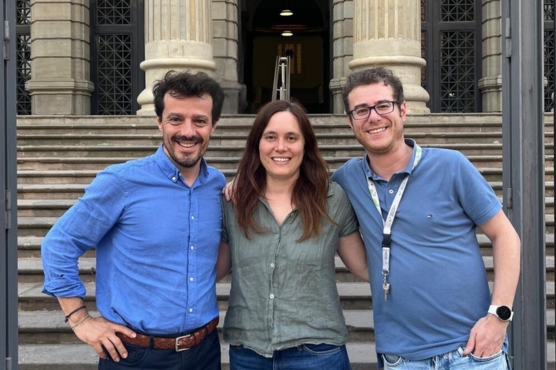A total of 1 million stem cell transplants have been performed worldwide

Marta, from Madrid, underwent a transplant from a non-related donor in 2002 to beat the leukaemia she was suffering. On the left, with her nurse in the isolation camera. On the right, today, promoting the fight against leukaemia in the streets of Madrid.
The Worldwide Network for Blood and Marrow Transplantation (WBMT) has announced recently this milestone achieved at the end of 2012. The WBMT is a non-profit scientific organization whose goal is to promote excellence in the fields of stem cell transplantation, hematopoietic donors and cellular therapy.
“One million transplants is a number that can surprise a lot of people, for stem cell transplantation was seen as an uncommon procedure until the end of the 20th century“, said Prof. Niederwieser, WBMT president, who collaborates with the José Carreras Foundation in Germany and is a haematologist at the Leipzig University Hospital in Germany. “Thanks to the fundamental discoveries and the exemplar cooperation of many scientists and doctors over the world, the technic in this type of transplants has been improved spectacularly over the last years.”
Stem cell transplants: bone marrow, peripheral blood and umbilical cord blood
The first autologous stem cell transplant was undergone by Dr. E. Donnall Thomas in 1957. Dr. Thomas, who passed away recently, received the Medicine Nobel prize in 1990 for the pioneer use of this treatment. This renowned scientist was one of the founder board members of the José Carreras Foundation against Leukaemia. Our entity, also, offers since 1991, a grant for young scientists which carries his name.
In Spain, the first bone marrow transplant was undergone by Prof. Ciril Rozman at Hospital Clínic in Barcelona. Prof. Rozman is one of the most relevant figures in Internal Medicine in Spain and was vice-president of our entity until his recent retirement.
At the end of 1960, because the knowledge of histocompatibility needs between patients and donors evolved, allogeneic transplants (where the stem cells come from a donor) were already being performed successfully. The first allogeneic transplants were performed with a compatible sibling’s stem cells.

A young leukaemia patient, Amanda, receiving the stem cells of his brother, Jonathan, who fortunately was compatible with her, at the Niño Jesús Hospital in Madrid.
In 1973, in New York, the first successful transplant between two non-related people was performed, when a young boy received a stem cell transplant from a non-related donor identified compatible through a Danish blood bank. In 1988, the first umbilical cord blood transplant was done effectively in Paris.
An umbilical cord blood unit stocked in the Barcelona Umbilical Cord Blood Bank.
Today, more than 70 malignant and non-malignant diseases are typically treated with a stem cell transplant. This intervention, which is perfected day by day, has offered more and better opportunities for many patients, especially leukaemia and lymphoma patients.
It is important to underline that this number would never be possible without the more than 20 million bone marrow donors and the more than 550,000 umbilical cord blood units stocked around the world. For most patients who require this type of transplant, the only opportunity of recovery is finding a compatible donor but only 1 in every 4 patients has a compatible brother.
In Spain, the organism in charge of searching for bone marrow, peripheral blood or umbilical cord blood donors is the REDMO (Spanish Bone Marrow Donors Registry), created and managed by the José Carreras Foundation, with the support of the Spanish Health Ministry. According to Dr. Enric Carreras, REDMO’s director, “the creation of the voluntary donors’ registry and of the umbilical cord blood bank came to palliate the difficulty of finding a compatible donor with a patient. Today, thanks to the more than 20 million voluntary registered donors and the more than 550 thousand umbilical cord blood units cryopreserved, the probability of finding a donor or a compatible unit with a patient is around 60-70% in adults and 80-90% in children. Furthermore, the recent progress in non-related donor transplants has led to the fact that, nowadays, a transplant performed from a non-related and full compatible donor can have better results than the ones achieved with an identical HLA sibling. In the same way, the use of umbilical cord blood is offering similar results to the ones achieved with compatible donors, specially, in paediatric patients.” Since the foundation of the registry, REDMO has coordinated 5,194 stem cell transplants from non-related donors around the world: 1,129 bone marrow, 1,494 peripheral blood and 2,571 umbilical cord blood.
If you want more information on bone marrow donation, click HERE.
* Autologous transplants are those that proceed from cells of the same patient; related allogeneic are those that proceed from a donor’s cells, mainly of a brother; and allogeneic non-related are those that proceed from a voluntary donor’s cells.







